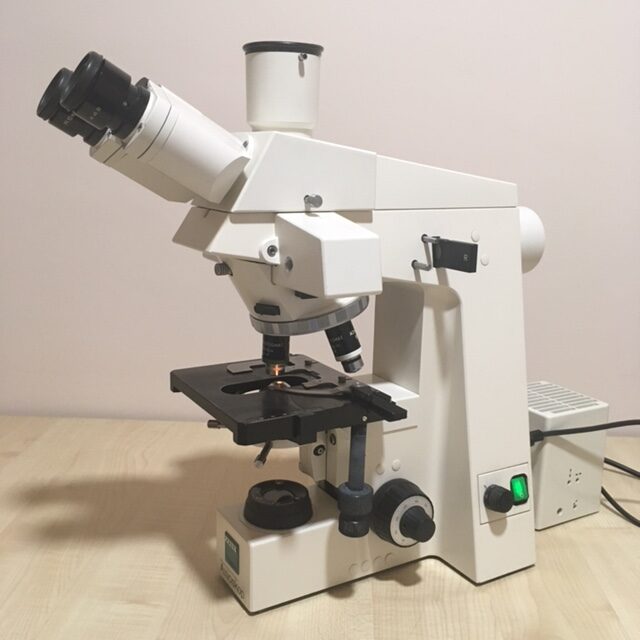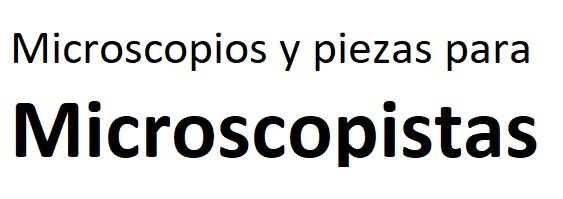
Among the professional microscopes of the big brands that have been sold the most over the last 30 years is the Axioskop range from Zeiss. Specifically, we are going to talk here about the Zeiss Axioskop 50. It is a very good microscope that does everything you can ask for from a quality instrument. It is robust, with considerable weight, but does not take up much space on the table. It is mechanically accurate. Its focus system is simple and effective. It has good lighting. It comes standard with a 50w lamp, although it is prepared to reach 100w. It is very expandable, because Zeiss manufactured all the necessary accessories. Optically it has a great quality, wide field of view and all kinds of lens and technical settings. So the ZEISS Axioskop 50 is a great microscope. We are going to analyze it briefly in this post.
The Stand
The first thing that strikes you about the Zeiss Axioskop 50 is the slenderness of its stand. Generally microscopes in its category are wider. The base of the Axioskop is T-shaped. Its four supports on the table are designed to provide great stability. It has two in the back, further apart, and two in the front, almost together. Actually, most microscopes have this arrangement, also the Olympus BX series and Leica DMs. But the Axioskop is narrower. Its narrowness, which would seem to be a stability drawback, is not, thanks to its good construction. The rubber “feet” are elastic and firm enough to make the Axioskop a very stable instrument. At the same time, being narrower leaves us a lot of free space on the table, and access to the back is easier

The front of the base is quite narrow. No more room is needed to accommodate the mirror and field diaphragm system. This way we have a lot of space on the table. Let’s look at a later image.

Here the considerable size “house of the lamp” stands out. It can accommodate up to a 100w lamp, although for that we must have an external power supply. With the source incorporated into the microscope, as seen in the image, the maximum allowed is a 50w lamp, sufficient for most techniques. In this model we can also see the train for overhead lighting, in which the same illuminator can be installed for incident light in brightfield or an illuminator for fluorescence. We also see the green power button and the knob for adjusting the brightness.
Accesories and other elements
Incident illumination
The microscope supports a wide variety of configurations and comes in many different ways. A basic system would be a binocular, without optovar and exclusively diascopic or transmitted lighting. In the model in the image above, we see that it is available for episcopic top lighting. This is a great advantage because it allows us to access all the techniques that require this type of light source. For this type of lighting we have a centrable field diaphragm, as well as a filter holder in the form of a slider. Below we can see the breakdown of the elements that compose it.


Rear view. 
As we have said before, the same illuminator that is used for the transmitted light technique can be placed for the incident light.
The head.
The head can be basically binocular or trinocular. Within the trinocular heads we have several different types. In this case, in the first photo we see that the head admits the image output towards the eyepieces, towards the phototube or in a 30/70% ratio between eyepieces and phototube respectively. There is another more basic model that only allows you to select between eyepieces or phototube.

100/100/70-30 
100/100
The external difference between the two models is a control with a black ball at its end located on the left side of the head and a diagram with the different configurations in the more configurable upper model, while the head that only allows choosing between eyepieces or phototube it’s all white.
The insertion diameter of the eyepieces is 30mm and the tube has a slit in its upper part where some eyepiece models fit so that it does not rotate. Not all eyepieces have these characteristics, which are manifested by the presence of a small screw on the side of the eyepiece that fits into the slit. Personally I find it very useful because sometimes I use an eyepiece adapter for photography with my mobile phone. By not rotating the eyepiece due to the weight of the phone, the image appears centered and in position.

Eyepiece with screw. 
Eyepiece insert into tube.
Optovar or Fluorescence filter holder.
Zeiss invented a very successful system for its Standard series microscopes: the Optovar. In the Axioskop, the system was preserved although with fewer features. Basically it is an optical system that allows to increase the optical capacity of the microscope by 1.25x and 1.6x on the selected objectives. Thus, with a 100x objective and a 10x eyepiece we reach 1000x magnification. but with the Optovar system we get up to 1250x even 1600x. Obviously, the resolution capacity is not going to improve because, as is known, it depends directly on the numerical aperture of the objective, but in many cases the Optovar is a great resource. Let’s see some images of the system.

Optovar 
1,25x 
1,6x
This Optovar in the photograph has a superior grip and therefore is installed without the characteristic fins that some Axioskops have, such as the one in the second photograph above, which mainly serve to protect from dust. In those cases the Optovar slides using a lower grip.
In the place of the Optovar and with the same dimensions, the Zeiss fluorescence filter holder can be inserted, which in the Axioskop 50 does not yet work with the cube system, but with independent filters and mirrors. Up to four positions present the portafilters that can be configured at will.

Four position filter holder 
Three position filter holder
Elements of transmitted lighting.
After the illuminator that we have already talked about, there is a filter and a collecting lens that directs the light towards a completely closed mirror that is part of the field diaphragm. It is very compact and easy to replace.

Collecting lens. 
Diaphragm lens and mirror 
Frontal view.
Among these elements there is a rubbed or frosted glass whose purpose is not well known. It’s on the right side of the base, next to the focus knob. It can be removed or placed in the path of the light with the help of a 3mm allen key and is used for the correct lighting configuration. To see the filament of the lamp.
Nosepiece.
It usually has a capacity for six objectives. It is very wide and robust and makes the difference with more modern or lower-end microscopes. Quite heavy, it is very easy to assemble and disassemble with its eight upper screws, which fix it to its support and to the stand. Its operation is very smooth thanks to its very wide ball bearing track, with very marked “clicks” in the positions of the objectives.
The knob seen in the third photograph, to the left of the nosepiece (in its normal position it would be in front of the microscopist) has to do with the Optovar or the fluorescence filter holder. To extract these elements you have to pull towards us to release the accessories that we mentioned.
Stages and condensers
There is quite a variety of plates with different sizes, with controls on the left and right. As a curiosity, to say that most stages of the Standard series microscopes fit the Axioskop, at least the most modern of the gray models, which are fastened with four screws. The only thing is that they have the XY coaxial control slightly shorter than the original ones for the Axioskop. In previous images we can see the typical 0.9 NA Zeiss condensers with a flip-up lens, and here below a condenser for phase contrast and dry dark field.

A Zeiss Standard stage 
Phase/Dark field condenser.
In later posts we will comment on the optical elements and their characteristics, as well as the adjustments that must be made to the microscope for optimal operation and thus get all their capabilities.
In short, the Zeiss Axioskop is a very robust and versatile microscope. With simple and very effective mechanics. It is not a delicate microscope that is easily misaligned. It is very strong and robust and easy to disassemble and adjust. It has many accessories at a very good price. It is of optics corrected to infinity and with an unbeatable image quality.
A very good choice.





